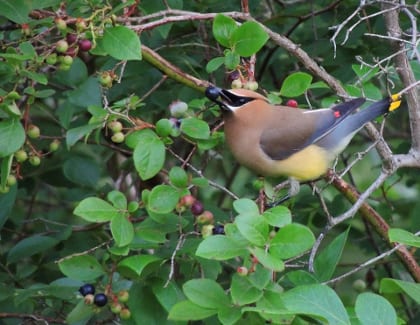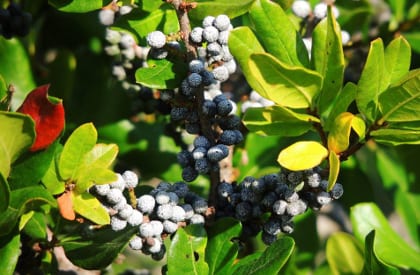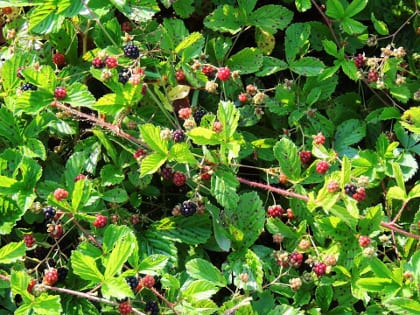by Anthony J. Zemba
Now that spring is here and our migrant songbirds have returned to our yards, gardens, and woodlands it is a time to consider giving something back to these amazing creatures in return for their beautiful color and melodic songs. Now is the time to scorn the barberry, privets, and other nasty invasives in favor of native shrubs with high wildlife value. Although non-native shrubs provide some cover for birds, they generally have little nutritional value for them and they disrupt the general ecology. Instead, chose a native shrub for landscaping. There are a number of excellent selections available at local native plant nurseries. Here are some of my favorites.
Blueberry is an excellent first choice for birdscaping yards, gardens, and wildlife preserves. Dozens of bird species are known to feed on the berries (and of course humans relish the berries too). In our area, this shrub will attract Gray Catbirds, American Robins, Eastern Bluebirds, and Orchard Orioles, among others, and many songbirds will nest within the foliage as well. The flowers are an excellent source of pollen for our native pollinators in the spring, and the foliage turns a beautiful deep red in autumn. Highbush Blueberry (Vaccinium corymbosum) grows in full sun to partial shade but does best in full sun on wet to moist, acidic soils while its shorter cousin, the Lowbush Blueberry (V. angustifolium) grows in dry, acidic soils.
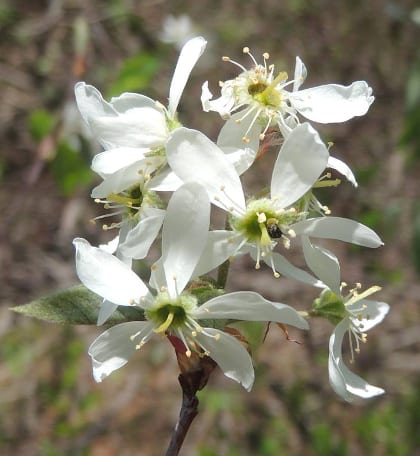 Serviceberry (Amelanchier canadensis) is a shrub with an erect spreading growth habit. It will attract woodpeckers, thrushes, catbirds, bluebirds, cardinals, robins, Brown Thrasher, Eastern Towhee, Cedar Waxwing, Baltimore Oriole, and a host of other songbirds that feed on its fruit (which is also edible to humans). Spring blooms attract pollinators and other insects which, themselves, provide food for our native songbirds. It will grow in a variety of habitats ranging from moist soils at the edge of wetlands (A. canadensis) to drier rocky hillsides and thickets (A. arborea) . This shrub will grow in full sun to partial shade.
Serviceberry (Amelanchier canadensis) is a shrub with an erect spreading growth habit. It will attract woodpeckers, thrushes, catbirds, bluebirds, cardinals, robins, Brown Thrasher, Eastern Towhee, Cedar Waxwing, Baltimore Oriole, and a host of other songbirds that feed on its fruit (which is also edible to humans). Spring blooms attract pollinators and other insects which, themselves, provide food for our native songbirds. It will grow in a variety of habitats ranging from moist soils at the edge of wetlands (A. canadensis) to drier rocky hillsides and thickets (A. arborea) . This shrub will grow in full sun to partial shade.
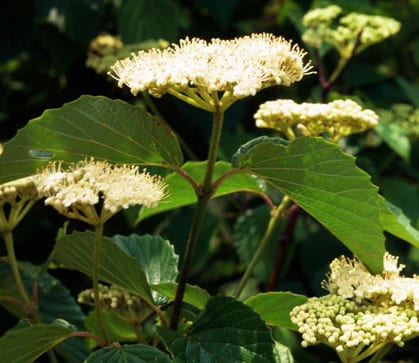
“Viburnum dentatum flowers” by Ted Bodner, Southern Weed Science Society/James H. Miller, USDA Forest Service – This image is Image Number 1120609 at Forestry Images, a source for forest health, natural resources and silviculture images operated by The Bugwood Network at the University of Georgia and the USDA Forest Service. Licensed under CC BY 3.0 us via Wikimedia Commons
Viburnums provide food for Ruffed Grouse, Wild Turkey, Pileated Woodpecker, robins, Brown Thrasher, Great Crested Flycatcher, Cedar Waxwing, Gray-cheeked, and Hermit Thrush who relish the fruits during fall migration. Viburnums grow in full sunlight but will tolerate partial shade. Collectively, these species cover all the ranges of soil moistures. American Cranberrybush (V. trilobum) and Wild Raisin (V. cassinoides) grow in wet areas (the former preferring moist woods and bogs, while the latter prefers shrub swamps and forested wetlands), making them fine choices for wetland mitigation plantings. Both grow in full to partial shade conditions. Arrowwood (V. dentatum) is also considered a wetland shrub but will grow in upland areas in fine-textured soils with high moisture-holding capacity. Give it room to grow, as many arching stems will emerge. Nannyberry (V. lentago) grows a bit taller, and also has arching stems forming distinct clumps. It prefers a bit drier soil moisture content than arrowwood. The latter two are both relatively shade tolerant, but plant it in full to partial sun for best expression.
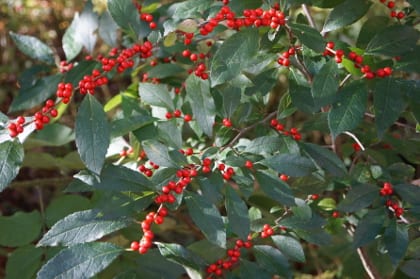 Winterberry (Ilex verticillata) is a member of the holly family, but unlike its more popular cousin the American Holly (which is also a great native plant for songbird food and cover) it is a deciduous multi-stemmed shrub rather than an evergreen tree. It is still a beautiful addition to a native birdscaped yard or garden, producing bright red fruit in the late summer contrasting against dark green foliage. The fruits produced on this shrub are not a preferred food for songbirds, but persist on the branches late into winter and are thus available when other foods are scarce.
Winterberry (Ilex verticillata) is a member of the holly family, but unlike its more popular cousin the American Holly (which is also a great native plant for songbird food and cover) it is a deciduous multi-stemmed shrub rather than an evergreen tree. It is still a beautiful addition to a native birdscaped yard or garden, producing bright red fruit in the late summer contrasting against dark green foliage. The fruits produced on this shrub are not a preferred food for songbirds, but persist on the branches late into winter and are thus available when other foods are scarce.
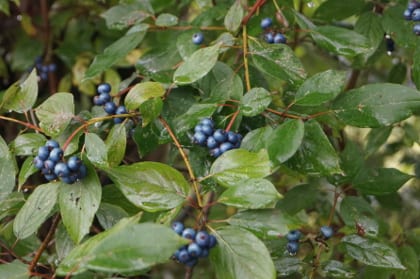 Dogwoods are great choices for ecological landscaping. Their fruits attract Wild Turkey, Northern Flicker, bluebirds, cardinals, robins, catbirds, Cedar Waxwings, Red-eyed Vireo, Warbling Vireo, Pine Warbler, Purple Finch, and such specialties as Ruffed Grouse, Yellow-breasted Chat, Brown Thrasher, Hermit Thrush, and Gray-cheeked Thrush. Some of the fruits may persist into winter adding even more value as wildlife food. The bright red stems of the multi-stemmed Redosier Dogwood (Cornus sericea) provide colorful interest to the winter landscape. It blooms from June to August in our area producing white flowers and white fruit. Give it room to grow, since the shrub will spread by stolons (as will the Silky Dogwood) producing a low, thick cover for wildlife. Silky Dogwood (C. amomum) blooms from May to July producing blue and white fruit in autumn. Both of these shrubs prefer wetter soils. In soils that are a bit drier but still moist, Gray Dogwood (Cornus racemosa) may do better. Alternative-leaved Dogwood (C. alterniflora) does best in rich, upland soils. All are moderately shade tolerant.
Dogwoods are great choices for ecological landscaping. Their fruits attract Wild Turkey, Northern Flicker, bluebirds, cardinals, robins, catbirds, Cedar Waxwings, Red-eyed Vireo, Warbling Vireo, Pine Warbler, Purple Finch, and such specialties as Ruffed Grouse, Yellow-breasted Chat, Brown Thrasher, Hermit Thrush, and Gray-cheeked Thrush. Some of the fruits may persist into winter adding even more value as wildlife food. The bright red stems of the multi-stemmed Redosier Dogwood (Cornus sericea) provide colorful interest to the winter landscape. It blooms from June to August in our area producing white flowers and white fruit. Give it room to grow, since the shrub will spread by stolons (as will the Silky Dogwood) producing a low, thick cover for wildlife. Silky Dogwood (C. amomum) blooms from May to July producing blue and white fruit in autumn. Both of these shrubs prefer wetter soils. In soils that are a bit drier but still moist, Gray Dogwood (Cornus racemosa) may do better. Alternative-leaved Dogwood (C. alterniflora) does best in rich, upland soils. All are moderately shade tolerant.
Bayberry (Morella pensylvanica) is a good choice for ecological landscaping in hot, dry areas especially in areas of low soil fertility. Eastern Bluebird, Gray Catbird, Brown Thrasher, White-eyed Vireo, Red-bellied Woodpecker, Tree Swallow, and Yellow-rumped Warbler relish the waxy fruits, especially in late autumn or early winter.
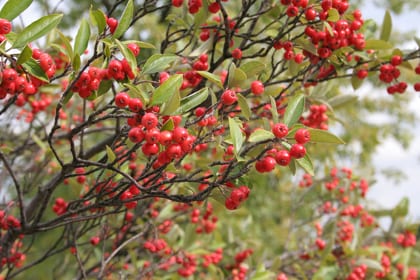
“Choke-Berries-IMG 2431 051013 121714”. Licensed under CC BY-SA 2.5 via Wikimedia Commons
Chokeberry (Aronia arbutifolia) offers another native choice for a fruit-producing, deciduous shrub with both aesthetic appeal and wildlife value. Its white flowers appear from April to July producing red fruit that often persists into winter. The shiny dark green leaves turn a brilliant red in autumn. Often billed as a wetland shrub (indeed it does grow in swamps and bogs) it can thrive in fine-textured, moderately-drained upland soils with high moisture-holding capacity.
Brambles (Rubus allegheniensis; R. occidentalis) are used by various bird species for food and include such specialties as Wild Turkey, Ruffed Grouse, Veery, Orchard Orioles, and Yellow-breasted Chats. These shrubs provide exceptional nesting coverage for those songbirds that nest on or near the ground. Dense stands of bramble canes provide cover for cottontail rabbits and other small mammals. Also the flowers provide native pollinators with a source of pollen, and the fruit is consumed by songbirds in late summer.
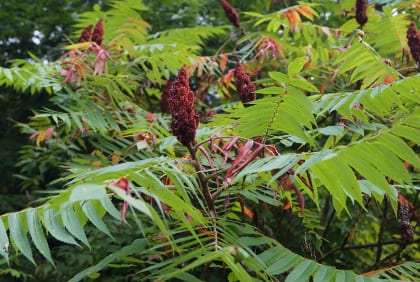 Sumacs (Rhus glabra, R. copallina, R. typhina), although often shunned by landscapers, are an excellent source of food for wildlife including Northern Flicker, Eastern Phoebe, bluebirds, robin, Hermit Thrush, mimic thrushes, cardinals, various other songbirds and game birds. The bark provides food for cottontail rabbits in winter. Although it’s not a preferred food, it provides important winter sustenance especially later in the winter season when other foods are scarce. Staghorn Sumac (Rhus typhina) has high drought tolerance and moderate salt tolerance making it a good choice for planting adjacent to roadsides. The red fruit that persists into winter adds color to an otherwise bleak landscape.
Sumacs (Rhus glabra, R. copallina, R. typhina), although often shunned by landscapers, are an excellent source of food for wildlife including Northern Flicker, Eastern Phoebe, bluebirds, robin, Hermit Thrush, mimic thrushes, cardinals, various other songbirds and game birds. The bark provides food for cottontail rabbits in winter. Although it’s not a preferred food, it provides important winter sustenance especially later in the winter season when other foods are scarce. Staghorn Sumac (Rhus typhina) has high drought tolerance and moderate salt tolerance making it a good choice for planting adjacent to roadsides. The red fruit that persists into winter adds color to an otherwise bleak landscape.
There are many other excellent choices for native landscaping that will benefit birds and other wildlife. As you consider your options:
- Be sure to visit native plant sales at your local agricultural extension centers.
- View the mature growth habits of the plants you are considering at some of the area botanical gardens or natural area preserves.
- Make sure you select shrubs grown from seed or stock that was collected locally.
- Be sure to protect small stock from deer grazing and plant the right shrubs in the right soil, sun, and drainage conditions.
Once established, these native shrubs will not only sustain wildlife, but also provide aesthetic value in flower, leaf, and fruit coloration through the changing seasons.
About the Author
Anthony Zemba is a Certified Ecologist with Fitzgerald and Halliday, Inc. a Connecticut-based planning firm.

